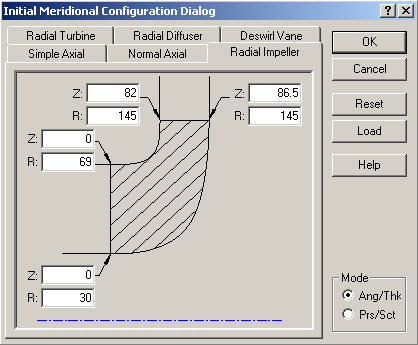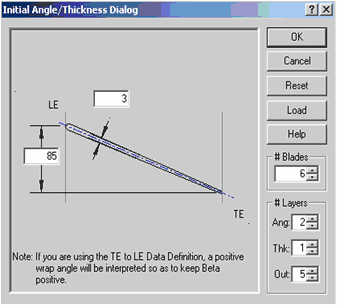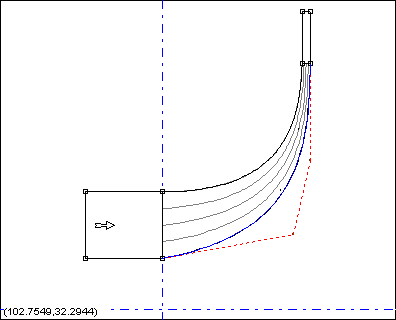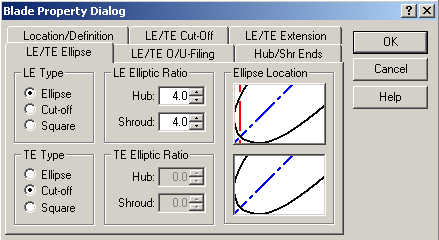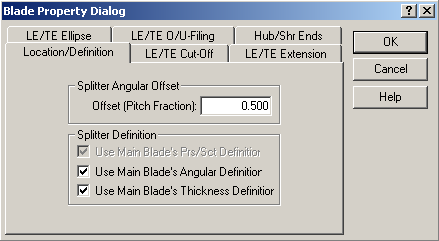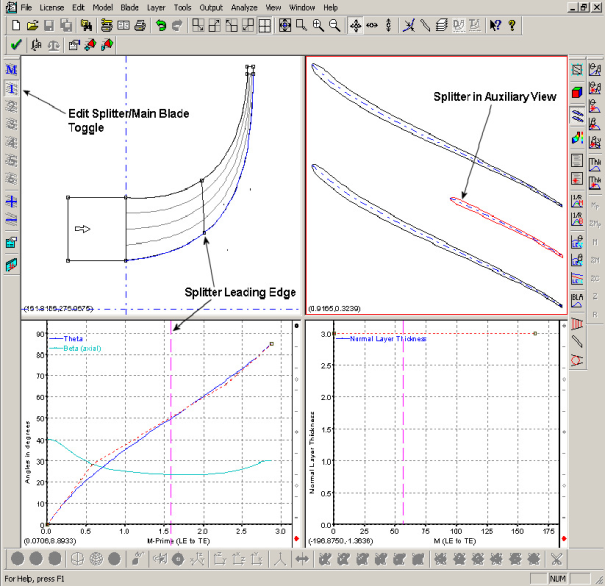The following topics are discussed:
- 9.2.6.1. Creating a Compressor Impeller with a Splitter Vane
- 9.2.6.2. Initial Design Parameters - Splitter Vane
- 9.2.6.3. Initial Angle/Thickness Parameters
- 9.2.6.4. Optimizing the Meridional View
- 9.2.6.5. Defining the Blade Shape at the Hub and Shroud in the Meridional View
- 9.2.6.6. Adjusting the Blade Angles at the Hub in the Angle View
- 9.2.6.7. Defining the Blade Thickness Profile
- 9.2.6.8. Prescribing the Leading/Trailing Edge Ellipse
- 9.2.6.9. Adding a Splitter Blade
- 9.2.6.10. Saving Your Model
The following procedure can be followed as an example of using BladeGen to create a Compressor Impeller with a splitter vane from start to finish.
BladeGen allows the user to create a blade system from scratch, using one of six standard initial configuration types. For this example, a Radial Impeller is used.
Select the File | New | BladeGen Model menu command or
 toolbar button which will display the Initial Meridional Configuration Dialog (shown in Figure 9.101: Initial Meridional Configuration Dialog)
toolbar button which will display the Initial Meridional Configuration Dialog (shown in Figure 9.101: Initial Meridional Configuration Dialog)
Select the Radial Impeller tab
Enter the parameters for the initial blade layout as shown in Figure 9.101: Initial Meridional Configuration Dialog.
Be sure to select Ang/Thk mode in the bottom right corner.
Press Enter or select the OK button to continue.
Using Figure 9.102: Initial Angle/Thickness Dialog the initial blade parameters are completed:
Enter the nominal wrap angle of 85 degrees, thickness of 3 and 6 blades.
Press Enter or select the OK button to display the BladeGen Window.
The most critical operation in the meridional view is to define the shape of the hub and shroud curve. The endpoints for these curves were specified when Initial Design Parameters were entered in the Initial Meridional configuration dialog.
The hub and shroud profile for this case are reasonably well defined automatically, but some modifications are helpful to smooth out the corner radius. This is done most easily by converting the curves to Bezier Segments.
Left-click the Hub curve
Right-click the mouse and select Convert Points to.. Bezier Control Points … from the pop-up menu.
In the Point Count Dialog, enter 4 points and select OK.
Align the new control points as in Figure 9.103: Meridional Profile.
Repeat this procedure for the Shroud curve.
The following topics are discussed:
The meridional profile is now defined and the Blade angles can be set. In the Angle View, the active layer is indicated by a red dot in the layer column on the right-hand side. By default, the hub layer is active. Once the Hub angles are set, the Shroud layer can be activated by left-clicking the black dot at the top of the layer column.
The blade angles can now be defined as follows:
Right-click in the Angle view and select Adjust Blade Angles
In the Leading Edge tab, enter 50° for the Tangential Beta value, the Beta value will automatically be updated as 90° minus Tang. Beta. Leave all the other values at zero.
In the Trailing edge tab, the Theta angle should be 85°. Enter 30° for the Beta value. The Tangential Beta value will be automatically updated as 60°. All other values can remain as zero.
Close the Blade Angle Dialog by selecting OK
The Theta curve will be automatically switched to a Bezier segment with 6 control points.
Left-click the black dot located at the top of the layer column to activate the Shroud layer. The blade angles can now be defined as follows:
Right-click in the Angle view and select Adjust Blade Angles
In the Leading Edge tab, enter 27.5° for the Tangential Beta value, the Beta value will automatically be updated as 90° minus Tang. Beta. Leave all the other values at zero.
In the Trailing edge tab, enter a Theta angle of 84° and enter 30° for the Beta value. The Tangential Beta value will be automatically updated as 60°. All other values can remain as zero.
Close the Blade Angle Dialog by selecting OK
The Theta curve will be automatically switched to a Bezier segment with 6 control points.
At this time, the Blade thickness can be defined in the Thickness view. For this example, a constant thickness of 3mm will be used and no modifications are required.
Select Blade | Properties menu commands or the ![]() toolbar button located on the left hand side of the BladeGen window to set the blade properties. Set the Leading Edge/Trailing Edge Ellipse tab; adjust the values as shown in Figure 9.104: LE/TE Ellipse Settings. All other values can remain unchanged.
toolbar button located on the left hand side of the BladeGen window to set the blade properties. Set the Leading Edge/Trailing Edge Ellipse tab; adjust the values as shown in Figure 9.104: LE/TE Ellipse Settings. All other values can remain unchanged.
Now that the main blade is defined, a splitter blade can be added. For more detailed information on splitter blades, refer to Blade Settings .
Splitter blades can be dependent on the main blade for their angular and thickness definitions or have their own, independent, definitions. For this example, the splitter blade will be made dependent on the main blade. Create the Splitter Blade as follows:
Choose the Blade | Add Splitter menu command or the
 toolbar button. The Blade Property Dialog will open (Figure 9.105: Splitter Blade Properties).
toolbar button. The Blade Property Dialog will open (Figure 9.105: Splitter Blade Properties).
The default values in the Location/Definition tab will be used. This will place the splitter blade at main blades mid-pitch and set the angular and thickness definition as dependent upon the main blade.
Select the Leading Edge/Trailing Edge Ellipse tab, set the Leading Edge Elliptic ratio to 4.0 for both hub and shroud.
In the LE/TE Cut-Off, Enable the Leading edge option and enter 0.35 for the hub and 0.4 for the shroud. Click OK.
After the splitter has been added, there are some new features in the GUI to note, as annotated in Figure 9.106: Graphical Layout after adding the Splitter Blade.
Upon exiting BladeGen, the blade model is automatically saved to a file associated with the Workbench project. You must save the project before closing it in order to retain the project files. You can save the project from the Workbench interface as usual. You will be prompted for a project name if you have not previously saved the project. The File | Save menu command (Save ![]() toolbar button) can function as an alternative way to save the project; see Saving a Blade Model for details.
toolbar button) can function as an alternative way to save the project; see Saving a Blade Model for details.



